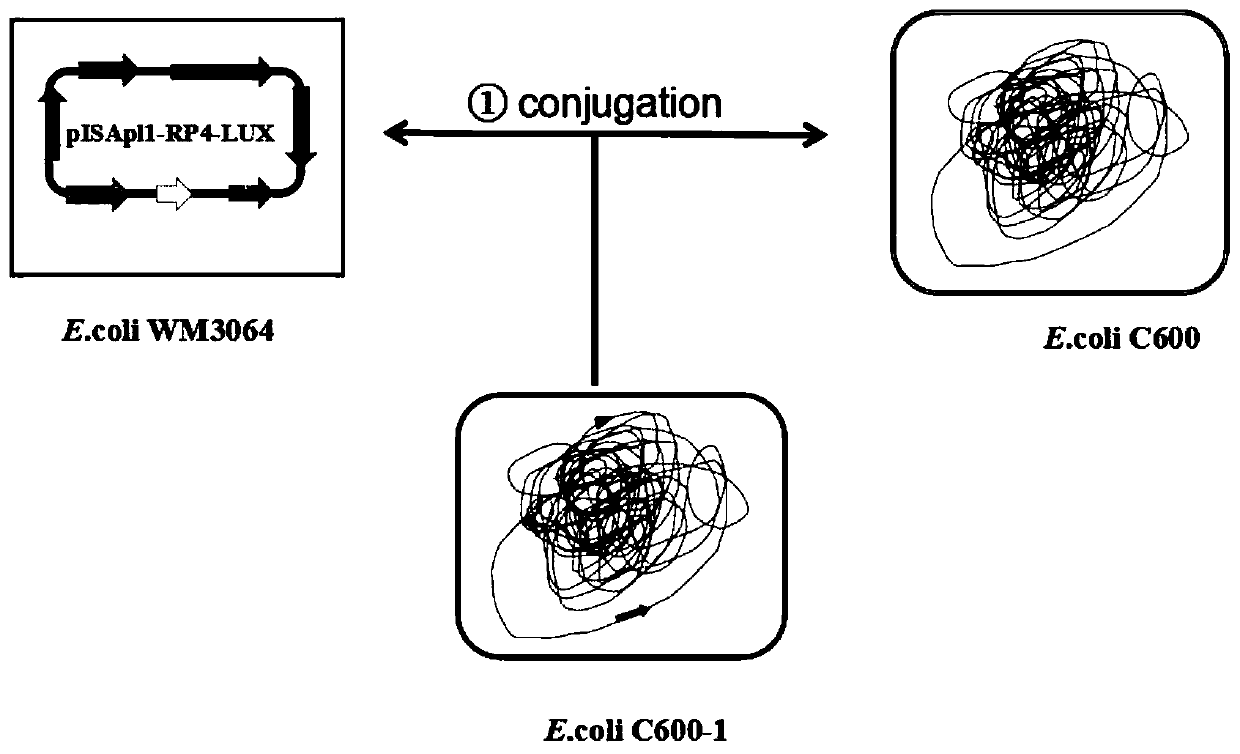Fluorescent strain E. coli C600 and construction method and application thereof
A construction method and fluorescence technology, applied in the field of genetic engineering, can solve the problems of inability to use, inability to utilize lactose, and require a lot of work, and achieve the effect of strong stability
- Summary
- Abstract
- Description
- Claims
- Application Information
AI Technical Summary
Problems solved by technology
Method used
Image
Examples
Embodiment 1
[0056] The construction of embodiment 1 fluorescent E.coli C600-1
[0057] The method for constructing E.coli C600-1 based on ISApl1 insertion sequence transposition mutation technology, specifically as follows figure 1 shown.
[0058] 1. Construction of pTFX-RP4-lux plasmid
[0059] The present invention inserts the suicide type R6k replicon (GenBank accession number: MH626522.1.(504...892)), Lux gene cluster (GenBank accession number: KX670548.1.(3429...9187)), ISApl1 insertion sequence (GenBank accession number: MH924589.1.(219,280..220,203)), tellurite resistance gene (tpm) (GenBank accession number: KX397287.1.(4,473..5,126)), RP4 conjugative transfer gene (GenBank Accession number: AJ868289.1.(147..1,876)) were combined to construct a new plasmid pTFX-RP4-lux.
[0060] The following is one of the possible construction methods, but not limited to it:
[0061] Such as figure 2 Shown, the construction process of the pTFX-RP4-lux plasmid that the present invention comp...
Embodiment 2
[0086] Morphological observation of embodiment 2 fluorescent bacterial strain E.coli C600-1
[0087] The E.coli C600-1 that embodiment 1 obtains at tpm R After the resistant LB agar plate was cultured for 20 hours, at tpm R The morphology grown on the resistant LB agar plate is as follows Figure 4 As shown, black colonies of irregular size grew.
[0088] the tpm R The formula of the resistant LB agar plate is tryptone 10.0g / L, yeast extract powder 5.0g / L, sodium chloride 10.0g / L, agar 15.0g / L, pH value 7.0±0.2, final concentration 25μg / mL tellurite Sodium acid.
[0089] Will Figure 4 The agar plate is passed through a small animal living imager, and bacteria can be seen to produce biological fluorescence, such as Figure 5 .
[0090] The E.coli C600-1 that embodiment 1 obtains is on LB agar plate (prescription is tryptone 10.0g / L, yeast extract powder 5.0g / L, sodium chloride 10.0g / L, agar 15.0g / L, pH value 7.0±0.2), the colony was beige.
[0091] The E.coli C600-1 t...
Embodiment 3
[0092] Example 3 Verifies the ability of E.coli C600-1 to obtain exogenous DNA
[0093] The E.coli C600-1 (recipient bacterium) obtained in Example 1 and 12 clinical plasmid-mediated MCR-1 colistin-resistant Escherichia coli (donor bacteria, see Table 1 for details), the donor Somatic bacteria have been published in the literature: Sun J, Fang L X, Wu Z, et al. Genetic Analysis of the IncX4Plasmids: Implications for a Unique Pattern in the mcr-1 Acquisition[J]. Scientific Reports, 2017, 7(1): 424.
[0094] Table 1 Statistical table of bacterial markers
[0095]
[0096] Receive single colonies into 4mL LB test tube broth, shake culture at 37°C until logarithmic phase of growth, mix donor bacteria and recipient bacteria at a volume ratio of 1:1, take 20 μL and drop them into 24-well plates (perfusion per well 900μL LB agar), after static culture at 37°C for 4 hours, dilute the mixed cultured hatch with physiological saline to a suitable gradient (the number of colonies on t...
PUM
 Login to View More
Login to View More Abstract
Description
Claims
Application Information
 Login to View More
Login to View More - Generate Ideas
- Intellectual Property
- Life Sciences
- Materials
- Tech Scout
- Unparalleled Data Quality
- Higher Quality Content
- 60% Fewer Hallucinations
Browse by: Latest US Patents, China's latest patents, Technical Efficacy Thesaurus, Application Domain, Technology Topic, Popular Technical Reports.
© 2025 PatSnap. All rights reserved.Legal|Privacy policy|Modern Slavery Act Transparency Statement|Sitemap|About US| Contact US: help@patsnap.com



